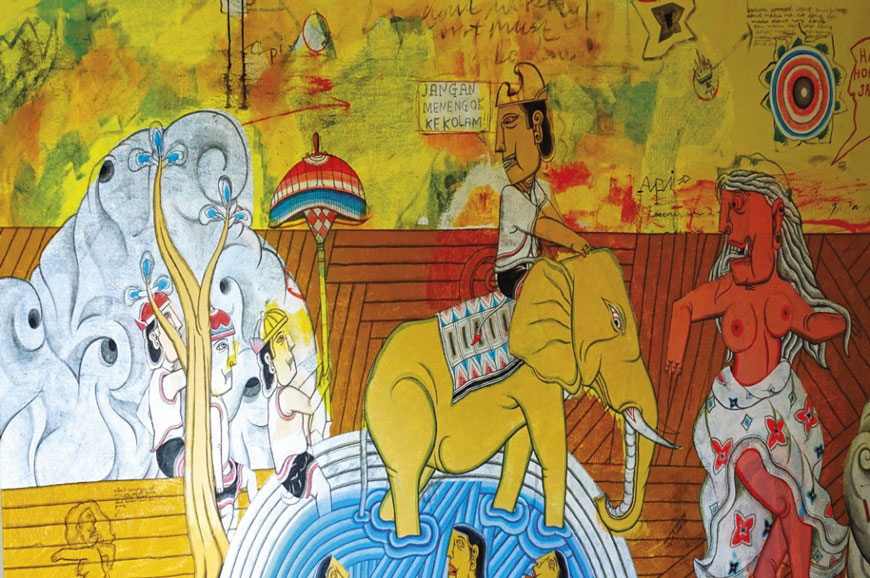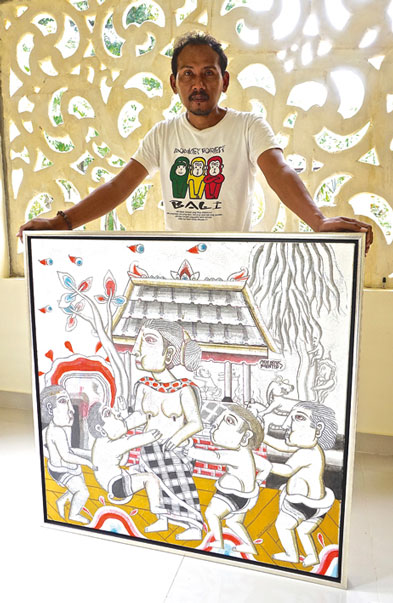Teja stands tall – almost as tall as his iconic paintings. His serious nature allows for no frivolity and he is a man of few words – his words and whimsy are reserved for his art.
Even though he was born in Tuban, his familial roots are from Klungkung – the home of Kamasan. This tiny community of artists had a far-reaching effect on Bali art styles from an early age. Until the early 20th century and even up until independence, all the royal raja courts of Bali would use artisans and painters from Kamasan. Even Bali’s traditional styles of painting derive from there.
You will recognize the Kamasan style if you see it. Anyone who has visited Klungkung’s Court of Justice will be shown the painted roof, presenting the best of Kamasan style. Figures are flat and two-dimensional, with a similar resemblance to the wayang shadow puppet characters. Colours originally came from the earth and are mostly all in tones of brown red yellow and white and black. Figures are traditional characters of legend – kings, queens, subjects, soldiers mixed with demons and characters of legend. It derived from ancient Java and was brought to Bali at the time of the great Majapahit Empire exodus.

Teja has taken it steps further and transformed this style into his own new and iconic modern style. His paintings are pleasing to the eye while retaining a hint of mystery.
As a youth he was obsessed with wayang – especially the Balinese shadow puppet play. He would make little puppets from the leaves of frangipani trees and play various stories from the Ramayana and the Mahabharata. Later at university he became a big fan of the famous Balinese painter, Nyoman Gunarsa and his Bali themed paintings. Although Gunarsa was an inspiration, Teja chose a different theme, drawing and painting in a flat wayang style. Later, when he discovered Kamasan, he became drawn into its style and ethos. Interestingly, even though he was born in Tuban, his ancestors hail from that area and it seems that he has Kamasan running through his veins. He resonates totally with this style.
Teja works with acrylic paint, blending his own colours. He uses tiny brushes to create detail and achieve that flat look that is so desirable. More recently he has begun flirting with texture, using a large scraper across his canvas to place his figures upon.
While the Kamasan style is rigid and traditional, Teja has brought it to life with added whimsy, new colours and an iconic style. So while it has an underlying traditional look, it is much easier on the eye. Kamasan revitalized.
He has of course participated in many exhibitions in Bali, Jakarta and abroad, including a recent one in Jeju Korea, where there has been a co-operation between some of Indonesia’s top artists and Korean artists.
His work features in collections in Frankfurt Museum, in Korea, in Tony Raka Gallery in Mas, in Jakarta and of course with private collectors. Now is a good time to buy his work as his star is rising.
His paintings don’t encompass just one size. Some are small cute takeaways under one metre, while his serious works can be up to three metres long. They are all delightful.
Text & photos by Ayu Sekar







